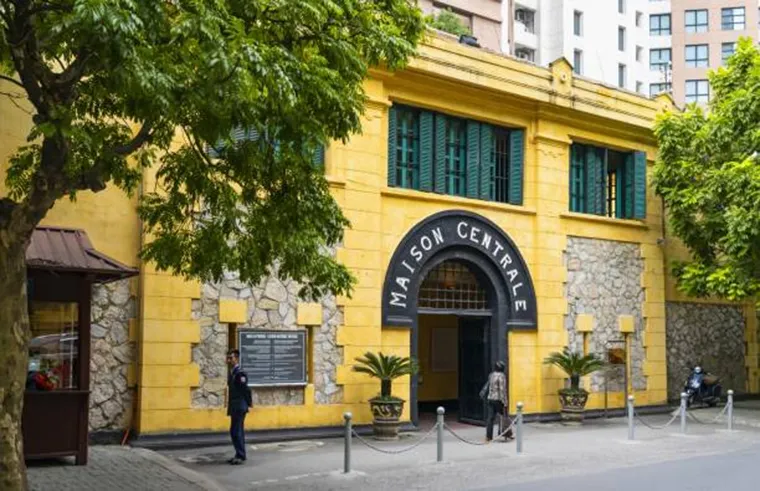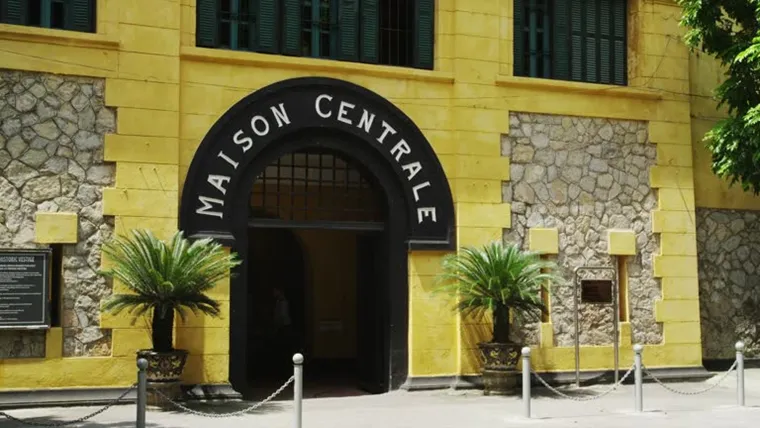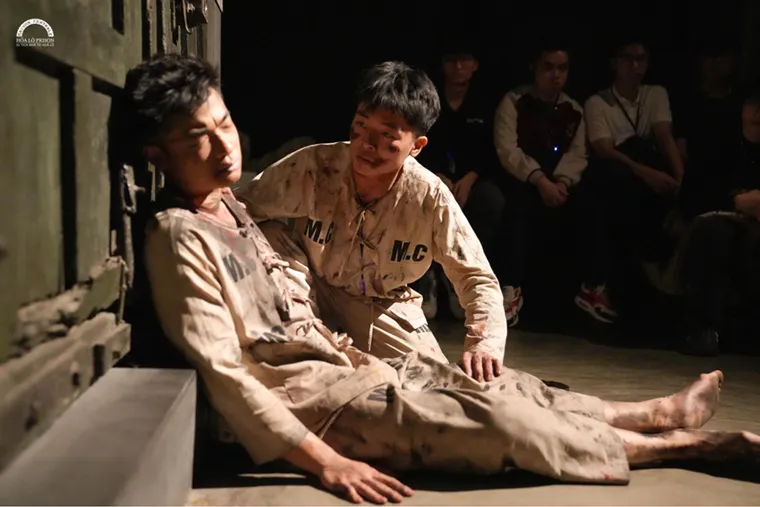Hoa Lo Prison: The Dark History Behind the “Hanoi Hilton”
Located in the heart of Hanoi, Hoa Lo Prison is one of the most haunting yet historically significant sites in Vietnam. Built by the French in the late 19th century, this prison was originally used to detain Vietnamese revolutionaries who fought against colonial rule. Later, during the Vietnam War, it became infamous as the place where American prisoners of war (POWs), including Senator John McCain, were held.
Today, Hoa Lo Prison Museum serves as a powerful reminder of Vietnam’s tumultuous past, offering visitors a glimpse into the struggles endured by both Vietnamese and American prisoners. A visit to this site provides a chilling yet educational experience, shedding light on the harsh realities of war, colonial oppression, and resilience.
1. The Origins of Hoa Lo Prison: A Colonial Nightmare
1.1. Construction and Purpose
Hoa Lo Prison was built by the French in 1896, during the colonial rule of French Indochina. While Hoa Lo became a symbol of colonial oppression, another notable example of French colonial architecture in Hanoi is the elegant Hanoi Opera House, built a few years later.
The name "Hoa Lo" translates to "Fiery Furnace" or "Stove," which originally referred to the area’s pottery-making industry. However, the name took on a more sinister meaning as the prison became notorious for its harsh conditions and brutal treatment of inmates.
Designed to hold 450 prisoners, the facility was soon overcrowded, with thousands of Vietnamese political prisoners, revolutionaries, and freedom fighters crammed into inhumane conditions. The French used Hoa Lo to suppress Vietnamese resistance, subjecting prisoners to torture, forced labor, and execution.
1.2. The Horrors of French Colonial Rule
Under French control, Hoa Lo Prison became a symbol of colonial oppression and cruelty. Prisoners were often subjected to:
-
Cramped, filthy cells, with little food or sanitation.
-
Torture methods, including beatings, whippings, and prolonged solitary confinement.
-
The notorious guillotine, used for public executions of revolutionaries.
-
Leg shackles and stocks, which prevented prisoners from moving or sleeping comfortably.
Despite these brutal conditions, Hoa Lo also became a center for resistance, with prisoners secretly organizing protests, hunger strikes, and escape attempts. Many revolutionaries who later became leaders in Vietnam’s independence movement—including figures from the Communist Party of Vietnam — spent time within its walls.

Situated in central Hanoi, Hoa Lo Prison stands as a hauntingly significant historical site in Vietnam. - Photo source: iStock
2. Hoa Lo Prison During the Vietnam War: The "Hanoi Hilton"
2.1. A Prison for American POWs
During the Vietnam War (1955–1975), the North Vietnamese government repurposed Hoa Lo to hold captured American pilots and other U.S. prisoners of war. The most famous detainees included:
-
John McCain (future U.S. Senator and presidential candidate)
-
James Stockdale (Medal of Honor recipient)
-
Everett Alvarez Jr. (the longest-held U.S. POW in Vietnam)
The American POWs sarcastically nicknamed Hoa Lo the "Hanoi Hilton," mocking the idea that it was a comfortable place. While North Vietnamese officials claimed they treated prisoners well, many former inmates described extreme physical and psychological torture.
2.2. Conditions and Treatment of POWs
Despite government propaganda depicting humane treatment, American POWs reported:
-
Beatings and physical torture, including the infamous "rope trick," where prisoners’ arms were tied behind their backs and pulled until their shoulders dislocated.
-
Isolation and psychological torment, with prisoners kept in solitary confinement for months or even years.
-
Malnutrition and unsanitary conditions, leading to illness and disease.
-
Forced propaganda participation, where POWs were coerced into making statements against the U.S. government.
Some prisoners, like John McCain, were offered early release for propaganda purposes, but many refused, choosing to endure hardship alongside their fellow captives.
2.3. Propaganda and Public Image
The North Vietnamese government used Hoa Lo as a propaganda tool, showcasing staged photos of smiling POWs playing chess, reading books, and receiving medical treatment. These images were meant to convince the world that prisoners were treated humanely, but accounts from released POWs tell a different story.

Hoa Lo Prison stands as a testament to the sacrifice, hardship endured, and resilient, indomitable fighting spirit of Vietnamese soldiers in the face of the enemy. - Photo source: Getty Images
3. Exploring the Hoa Lo Prison Museum Today
3.1. Preserved Structures and Exhibits
Today, Hoa Lo Prison Museum preserves much of the original French colonial architecture, including:
-
The original cells used for Vietnamese revolutionaries and American POWs.
-
A chilling display of the guillotine, symbolizing French brutality.
-
Leg stocks and chains, showing the suffering of prisoners.
-
Personal artifacts, including prisoner letters, photographs, and clothing.
3.2. Key Areas to Visit in the Museum
-
The French-era Cells – These dark, cramped rooms housed Vietnamese prisoners, many of whom were tortured or executed.
-
The Guillotine Room – One of the most haunting sections, where executions took place.
-
American POW Exhibit – Showcasing John McCain’s flight suit and stories of captured U.S. soldiers.
-
Escape Tunnel Display – A tribute to Vietnamese revolutionaries who successfully escaped the prison.
3.3. Visitor Experience and Atmosphere
Walking through Hoa Lo Prison is an eerie and sobering experience. The dim lighting, preserved shackles, and graphic photographs provide an unfiltered look at the pain and resilience of those imprisoned here.
Visitors often describe the museum as:
-
Emotionally intense – A powerful reminder of the suffering endured within its walls.
-
Historically enriching – Offering deep insights into Vietnam’s struggle for independence.
-
A must-visit in Hanoi – Essential for those interested in history, war, and human resilience.
Walking through Hoa Lo Prison is an eerie and sobering experience. For those interested in delving deeper into Hanoi's history beyond this poignant site, a visit to the imperial citadel of thang long hanoi offers a look into the city's imperial past.
4. Practical Information for Visitors
4.1. Location & Opening Hours
-
Address: 1 Hoa Lo Street, Hoan Kiem District, Hanoi, Vietnam
-
Opening Hours: 8:00 AM – 5:00 PM daily
4.2. Entrance Fee
-
Adults: 30,000 VND (~$1.30 USD)
-
Students (with ID): 15,000 VND (~$0.65 USD)
-
Children under 15: Free
4.3. Best Time to Visit
Early morning or late afternoon to avoid crowds. Visiting during cooler months (October – April) is recommended for a more comfortable experience.
For visitors interested in experiencing different facets of Hanoi's culture, a trip to bat trang ceramic village offers a contrast to the historical significance of Hoa Lo Prison.

Hoa Lo Prison in Hanoi: a haunting testament to Vietnamese resilience during wartime imprisonment. - Photo source: Facebook Di tích Nhà tù Hỏa Lò - Hoa Lo Prison Relic
Hoa Lo Prison is more than just a museum; it is a place of remembrance and reflection. Whether you are interested in Vietnamese history, colonial resistance, or the Vietnam War, a visit to this site will leave you with a deeper understanding of the struggles and sacrifices of those who lived through these dark times.
|
Joytime - Your Vietnam Journey's Servant Expert Follow us for travel tips, local insights, and exclusive offers:
|

Danish Nguyen
Danish Nguyen is a renowned travel blogger in Vietnam with over 5 years of experience sharing unique travel experiences. With a passion for exploring new places, Danish captures incredible moments and provides readers with valuable tips to discover the beauty of his homeland.








.webp)
.webp)








